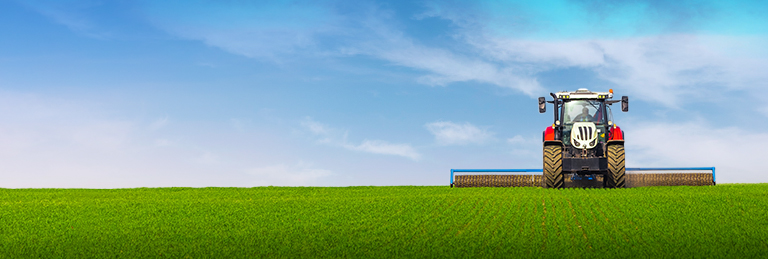The new LEXION 700 has also moved to the next level in the area of emission control. Now fulfilling the Tier 4 / Stage 4 emission treatment standard, CLAAS has changed its engine supplier for the LEXION 700 from CAT to Mercedes-Benz. The top-of-the-range 780 and 770 models are equipped with the latest generation Mercedes-Benz engine, which has a displacement of up to 15.6 litres. This provides the LEXION 780 with a maximum of 626 hp. The LEXION 750 and 740 models are powered by a Mercedes-Benz engine with 10.7-litre displacement. The exception to the rule is the new Perkins engine installed in the LEXION 760 model.
The LEXION 750 and 740 models have also been equipped with the DYNAMIC COOLING system with variable fan drive. This system only ever provides the exact level of cooling output which is actually required by the engine.
In keeping with the increased power of the machines, CLAAS has also enlarged the size of the grain tank on the two largest models, the LEXION 780 TERRA TRAC and 770 TERRA TRAC – to a maximum of 13,500 litres. With a discharge rate of 130 l/s, the contents of the grain tank can thus be transferred in less than two minutes.
LEXION 700 series
|
LEXION |
780 |
770 |
760 |
750 |
740 |
|
Threshing mechanism / width |
APS / 1700 mm |
APS / 1700 mm |
APS / 1420 mm |
APS / 1420 mm |
APS / 1420 mm |
|
Residual grain separation |
ROTO PLUS |
ROTO PLUS |
ROTO PLUS |
ROTO PLUS |
ROTO PLUS |
|
Grain tank capacity |
13,500 l or 12,800 l |
13,500 l or 12,800 l |
11,000 l |
10,000 l |
10,000 l or 9000 l |
|
Engine manufacturer |
Mercedes-Benz |
Mercedes-Benz |
Perkins |
Mercedes-Benz |
Mercedes-Benz |
|
Maximum engine output (ECE R 120) |
460 kW / 625 hp |
430 kW / 585 hp |
370 kW / 503 hp |
320 kW / 435 hp |
300 kW / 405 hp |
Representing the state of the art in residual grain separation technology, the LEXION 700 is equipped with five rotor concaves, with six installed on the top-of-the-range LEXION 780 model, and hydraulic rotor cover plates on the first two segments. On CLAAS machines, 3D cleaning previously represented the state-of-the-art in compensating for lateral tilt. In this process, active control of the upper sieve reduces matting on the sieve. Without this compensating function, there is a risk of cleaning and power losses during combine harvesting on hilly terrain. Naturally, this issue becomes more critical as the power of a machine increases.
The fourth dimension – 4D cleaning
For these reasons, CLAAS has developed 4D cleaning for the new higher-powered models in the LEXION 700 range. 4D cleaning consists of two components: slope-dependent rotor cover plate control and automatic blower control. Machines featuring 4D cleaning are also equipped with an additional third pair of rotor cover plates. Active control of the rotor cover plates takes place depending on the lateral and longitudinal angle of the machine as well as the current separation and cleaning output. In this process, the rotor cover plate segments facing the downward slope are automatically opened or closed as necessary. The blower speed is also automatically adjusted to uphill or downhill driving. The new 4D cleaning system therefore takes effect as early as the residual grain separation stage and thus reduces the amount of cleaning needed. 4D cleaning operates automatically in the background and does not need to be controlled additionally by the driver. It is fully integrated into CEMOS AUTOMATIC and contributes to the fully automatic machine optimisation system. Naturally, the driver can also intervene manually and shut off the system using the CEBIS terminal if required.
LEXION 750 now also as MONTANA
The two LEXION 760 and LEXION 750 models are now also available as MONTANA versions for harvesting on very hilly terrain and can compensate for a lateral slope of up to 17 %.
Improved spreading pattern – Larger chopper drums
CLAAS has also changed the dimensions of its straw choppers. The diameter of the drum on the new LEXION 700 has been increased by 5 cm, thus producing a more even chopping length and more uniform crop intake and guidance. In combination with a deflector plate spreader, the larger chopper drum improves the acceleration of the chaff and thus produces a wider and more even spread pattern on the field.
The new models also achieve a more even spread pattern when using the map-controlled radial spreader. The radial spreader has now been equipped with a mechanical drive for this purpose. The new radial spreader not only runs at a more stable speed but, in particular, also offers greater operating comfort and reduced fuel consumption.
The friction concave plate and the counter-knives of the chopper can now be conveniently adjusted hydraulically from within the cab via the CEBIS terminal. The driver is also able to change between the transport position, chopping and swathing at the touch of a button from within the cab.
Harvesting under difficult conditions – Automatic crop flow control
CLAAS combine harvesters are famous for being able to work to their strengths even under difficult harvesting conditions. The drive systems of the combine harvester are subjected to heavy loads in these circumstances. In order to detect critical load peaks at an early stage, CLAAS has developed an automatic crop flow control system for the new LEXION 700. This system monitors and compares the rotational speeds of the engine, the APS threshing mechanism and the ROTO PLUS residual grain separation system during operation. Should a problem ever arise, the feeder housing, the implement and the grain tank discharge system are shut off immediately and automatically so that a breakdown is avoided.
Practice makes perfect – CEMOS AUTOMATIC
CLAAS introduced the CEMOS AUTOMATIC system for the LEXION 700 in 2012 – it was the first fully automatic combine harvester adjustment system for separation and cleaning. Initially, the system was used in wheat, barley and rapeseed crops. However, CEMOS AUTOMATIC is a learning, self-optimising system, which has been continuously optimised since its market launch based on worldwide experience from actual harvesting operation. CLAAS is thus extending its usage spectrum on the new LEXION 700 to incorporate maize and soya crops, while also allowing the system to be operated directly via the CEBIS system of the machine. The control logic and menu guidance are thus identical to those used for all of the other machine functions.








